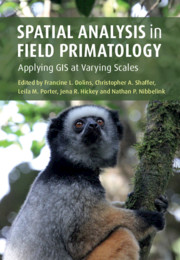19 results
8 - Quantifying Resource Dispersion in Free-Ranging Bearded Sakis in Guyana
- from Part II - GIS Analysis in Fine-Scale Space
-
-
- Book:
- Spatial Analysis in Field Primatology
- Published online:
- 29 January 2021
- Print publication:
- 18 February 2021, pp 152-179
-
- Chapter
- Export citation
Contributors
-
- Book:
- Spatial Analysis in Field Primatology
- Published online:
- 29 January 2021
- Print publication:
- 18 February 2021, pp x-xiii
-
- Chapter
- Export citation
Plate Section (PDF Only)
-
- Book:
- Spatial Analysis in Field Primatology
- Published online:
- 29 January 2021
- Print publication:
- 18 February 2021, pp 447-470
-
- Chapter
- Export citation
Copyright page
-
- Book:
- Spatial Analysis in Field Primatology
- Published online:
- 29 January 2021
- Print publication:
- 18 February 2021, pp iv-iv
-
- Chapter
- Export citation
Introduction
- from Part II - GIS Analysis in Fine-Scale Space
-
-
- Book:
- Spatial Analysis in Field Primatology
- Published online:
- 29 January 2021
- Print publication:
- 18 February 2021, pp 123-128
-
- Chapter
- Export citation
Acknowledgments
-
- Book:
- Spatial Analysis in Field Primatology
- Published online:
- 29 January 2021
- Print publication:
- 18 February 2021, pp xiv-xiv
-
- Chapter
- Export citation
Dedication
-
- Book:
- Spatial Analysis in Field Primatology
- Published online:
- 29 January 2021
- Print publication:
- 18 February 2021, pp v-vi
-
- Chapter
- Export citation
Index
-
- Book:
- Spatial Analysis in Field Primatology
- Published online:
- 29 January 2021
- Print publication:
- 18 February 2021, pp 434-446
-
- Chapter
- Export citation
Part III - GIS Analysis in Broad-Scale Space
-
- Book:
- Spatial Analysis in Field Primatology
- Published online:
- 29 January 2021
- Print publication:
- 18 February 2021, pp 307-433
-
- Chapter
- Export citation
Contents
-
- Book:
- Spatial Analysis in Field Primatology
- Published online:
- 29 January 2021
- Print publication:
- 18 February 2021, pp vii-ix
-
- Chapter
- Export citation
Part I - GPS for Primatologists
-
- Book:
- Spatial Analysis in Field Primatology
- Published online:
- 29 January 2021
- Print publication:
- 18 February 2021, pp 7-120
-
- Chapter
- Export citation
Part II - GIS Analysis in Fine-Scale Space
-
- Book:
- Spatial Analysis in Field Primatology
- Published online:
- 29 January 2021
- Print publication:
- 18 February 2021, pp 121-306
-
- Chapter
- Export citation

Spatial Analysis in Field Primatology
- Applying GIS at Varying Scales
-
- Published online:
- 29 January 2021
- Print publication:
- 18 February 2021
5 - Comanagement of Primate Hunting in Amazonian Indigenous Reserves
- from Part I - The Human–Non-human Primate Interface
-
-
- Book:
- Primate Research and Conservation in the Anthropocene
- Published online:
- 25 January 2019
- Print publication:
- 31 January 2019, pp 74-98
-
- Chapter
- Export citation
Chapter 28 - Primate Community Structure at Three Flooded Forest Sites in Guyana
- from Part V - Primates in Freshwater Flooded Forests
-
-
- Book:
- Primates in Flooded Habitats
- Published online:
- 24 December 2018
- Print publication:
- 03 January 2019, pp 226-235
-
- Chapter
- Export citation
Chapter 45 - Conservation of Primates and Their Flooded Habitats in the Neotropics
- from Part VII - Conservation, Threats and Status
-
-
- Book:
- Primates in Flooded Habitats
- Published online:
- 24 December 2018
- Print publication:
- 03 January 2019, pp 359-374
-
- Chapter
- Export citation
18 - An Ethnoprimatological Approach to Assessing the Sustainability of Nonhuman Primate Subsistence Hunting of Indigenous Waiwai in the Konashen Community Owned Conservation Concession, Guyana
- from Part II - Following the Data: Incorporating Ethnography
-
-
- Book:
- Ethnoprimatology
- Published online:
- 16 February 2017
- Print publication:
- 23 February 2017, pp 232-250
-
- Chapter
- Export citation
Contributors
-
-
- Book:
- Intellectual Property and the Common Law
- Published online:
- 05 September 2013
- Print publication:
- 02 September 2013, pp ix-x
-
- Chapter
- Export citation
8 - Macaca fascicularis in Mauritius: Implications for macaque–human interactions and for future research on long-tailed macaques
- from Part III - Ethnophoresy of long-tailed macaques
-
-
- Book:
- Monkeys on the Edge
- Published online:
- 16 May 2011
- Print publication:
- 14 April 2011, pp 207-235
-
- Chapter
- Export citation

